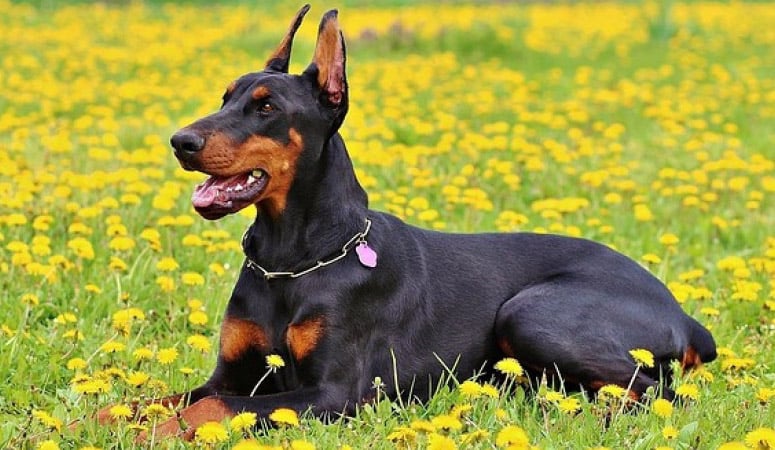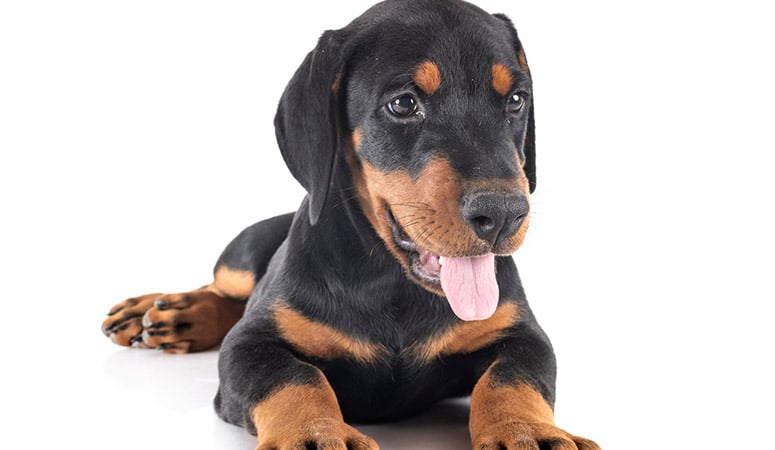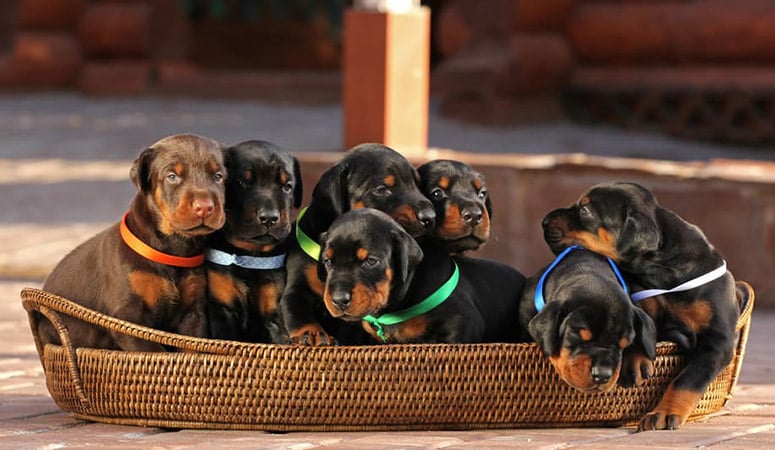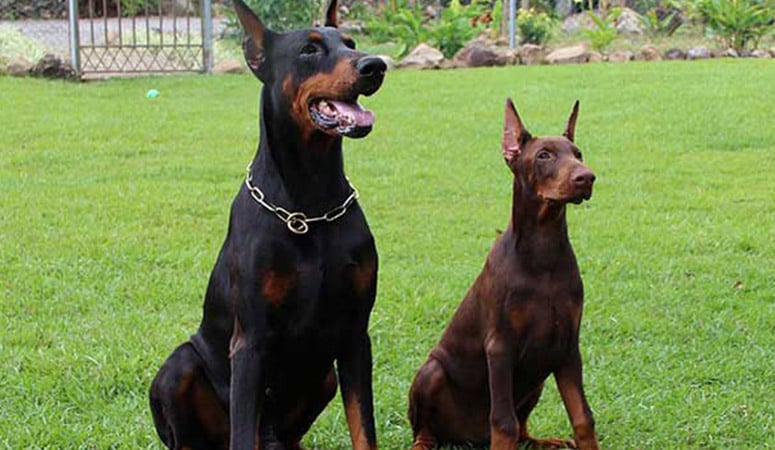Doberman Pinscher
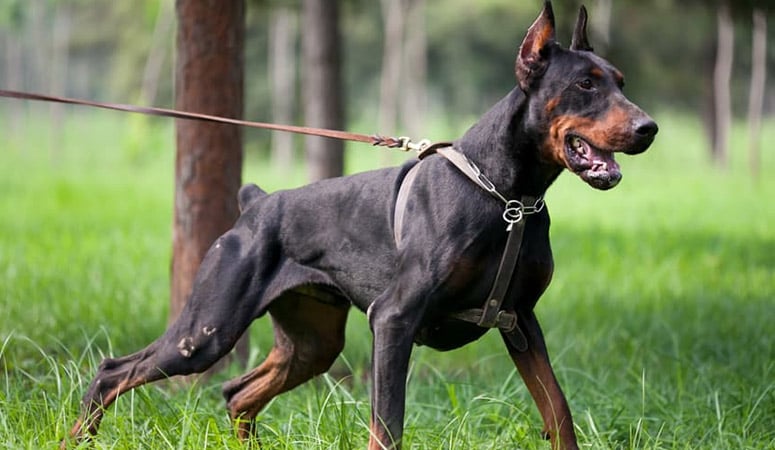
Powerful and intelligence, with a sleek coat, majestic appearance, and athletic build, the Doberman Pinscher is regarded as “nobleman” of the dogs. This unparalleled fearless and vigilant breed ranks proudly among the best protection dogs in the world, also they can do well in as family guardians and companions, canine sports, and military work.
| Other Names | Dobe, Dobermann |
| Color | Black & Rust, Blue & Rust, Fawn (Isabella) & Rust, Red & Rust, White |
| Height | Males: 26-29 inches. Females: 24-27 inches. |
| Weight | Males: 88-99 pounds. Females: 70-77 pounds. |
| Life Span | 10-12 years |
| Personality | Loyal, Fearless, Alert |
| Exercise | Needs Lots of Activity |
| Origin |
| Popularity | #19 |
| Groom Needs | Occasional |
| Kids Friendly | Yes |
| Dog Friendly | Yes with supervision |
| Watch Dog | Yes |
| Family Dog | |
| Litter Size | 6-8 |
Doberman Pinscher Pictures
Doberman Pinscher Video
Introduction
The idea behind the creation of the Doberman was for tenacity, strength, and agility, little wonder they have thick muscles and are sturdy as oaks. They are loyal and dutiful guard dogs. Covered by a short, smooth coat of two colors, a Doberman breed evinces a royal aura, adorned with a graceful gait to match with. The coat comes in different colors which include; black, blue, red, or fawn, each with tan markings around the chest, tail, muzzle, paws, and even around the eyes.
A male Doberman Pinscher has a more stocky build compared to the female. A standard male would weigh somewhere between 75 and 95 pounds where a standard female hits around 60 or 85 pounds. The males are usually slightly taller at the shoulder, mostly around 26-29 inches, while a female reaches a shoulder height of 24 or 25 inches. They are loyal and love being involved in family activities. Doberman Pinschers have an average lifespan of about 10-12 years.
Living with Doberman Pinscher
Doberman Pinscher’s coat is short, smooth, and hard, only needs occasional brushing, the regular grooming will help keep Dobermans in top condition. Weekly brush with a slicker brush or hound gloves can keep their coat shiny and healthy, or even just wipe their coat with a wet towel.
They don’t need to be bathed very often, just only a few baths per month. Using a dog shampoo, not a human product when bathing, and rinse thoroughly and let the dog shake dry or towel-dry him.
Brush the dog’s teeth at least two or three times a week for good overall health and fresh breath and remove tartar buildup and the bacteria that lurk inside it.
Trim their nails every few weeks to prevent chipping, and check their ears weekly for redness or a bad odor which can mean an infection for them.
The Doberman Pinscher has a lot of energy and endurance when needed, but in fact it is just a moderately active dog. The dog needs daily exercise, which can be a long walk or long jog with the owners or running in a large fenced area, also, games and sprints are helpful burn off energy.
Obedience training is not only important for control, but also for the psychological exercise it provides. Participating in canine sports (such as obedience, tracking, and agility) will provide physical and mental exercise and happy hours for dogs and owners.
To give enough exercise to Doberman can make him be a calm and alert housedog, otherwise, he may be too active and destructive.
High-quality dog food is very important to Doberman when feeding. Doberman Pinschers are meat-eaters indeed, but you couldn’t consider that a piece of meat every once in a while can keep a healthy diet to them. A healthy diet means to give the dog a proper amount of food for its weight and mix in meat with nutrient-rich foods such as dog chow and vegetables.
Doberman puppies should be fed a diet that approved by experts or veterinarians according to age. Treats may be an important aid in training, but excessive intake can lead to obesity. Also, the owners need to distinguish which human foods are safe for dogs and which are not.
There should be a sufficient amount of clean fresh water at all times, and if you have any questions about the dog’s weight or diet, please consult your veterinarian.
Breed health concerns may include bloat, hypothyroidism, cancer, chronic active hepatitis, cervical vertebral instability (Wobbler syndrome), color dilution alopecia, Von Willebrand disease, and dilated cardiomyopathy.
Other conditions include nasal depigmentation, dermoid, congenital portosystemic shunt, congenital deafness, arachnoid cysts, mucocutaneous hypopigmentation, entropion, “cherry eye”, cataracts and other ocular defects.
Suggested tests:
Thyroid Evaluation
Hip Evaluation
Cardiac Exam
Ophthalmologist Evaluation
Von Willebrand’s Disease DNA Test
Total Annual Cost: $3320
Cost is estimated for the first year and may vary depending on many factors, such as dog food, health care, leash, collar, licensing, possible fencing, crates, training and obedience classes, dog-walking, grooming, treats, toys, flea, tick, and heart-worm meds, microchips, etc.
Doberman Pinschers are well-known as guard dogs, and they have a high reaction ability to training, and they are almost completely obedient once trained. They are very smart, learn easily, respond quickly and become loving and fun companions. But if they didn’t get bred properly, they could be destructive and uncontrollable.
It is suggested to start training from a puppy, socialization and obedience training are imperative. And the owners need to take responsibility to make sure that the dog can be raised healthily both in body and spirit.
Besides, the Doberman Pinscher is considered to be one of the most well-trained dog breeds because they are smart, attentive, and eager to please. They are eager to train and like to study new skills.
History
The Doberman Pinscher is a name you would probably hear only in the U.S and Canada, as other countries have long dropped the Pinscher part of the name and rather called it Doberman, simply. This was because the Pinscher was a German word which meant ‘Terrier’, and although some experts claim that some Terrier breeds contributed to creating the Doberman Pinschers, they aren’t Terriers themselves.
The Doberman Terrier got his name from a German tax collector, Karl Friedrich Louis Dobermann, who is widely believed to have begun the development process of the Doberman breed. This was possible because he had unrestrained access to the dog pound, which afforded him various breeds at his disposal. Towards the end of the 19th century, Dobermann decided to create a dog breed to guard him, as tax collection was a dangerous job at the time. Strength, courage, intelligence, and agility were some of the characteristics Dobermann aimed at, so it was only natural to have settled for robust working breeds such as the Rottweiler, Beauceron, German Pinscher, Weimaraner and finally, the German Shepherd which probably contributed the largest ratio.
Otto Goeller took over developing the Doberman breed after the death of the breed patron in 1894. He went ahead to found the National Doberman Pinscher Club in the late 1890s. As time passed, the breed took on a winning reputation and it was only a matter of time before it was recognized in many other countries of the world, including America.
Helpful Information
Breed Club: DOBERMAN PINSCHER CLUB OF AMERICA
Breed Club Link: https://dpca.org/
Breed Club Rescue: DPCA DOBERMAN RESCUE
Breed Club Rescue Link: https://dpca.org/rescue/

